ZDP-189 is a powdered steel developed by Hitachi Metals Ltd. and known for its extreme hardness of 65–67 Rockwell. The hardness makes it highly durable with a long-lasting edge. However, this also makes it difficult to sharpen for home sharpeners. Blacksmiths and knifemakers do not commonly use it due to unique forging and heat-treatment requirements.
It may also be known as MC66 when used by Zwilling. The steel composition includes 3% Carbon and 20% Chromium, with the remaining makeup being proprietary.
Exploring the High Hardness of ZDP-189
The high hardness of ZDP-189 is a mystery that has yet to be fully understood. While other stainless tool steels have been found to have a maximum hardness of 63–65 Rc through heat treatment experiments, ZDP-189 can reach 70 Rc. To comprehend how this is possible, examining the factors that determine hardness and how ZDP-189 utilizes them is essential.
Carbon in the Martensite Structure
The critical element determining tool steel's hardness is carbon within martensite. By dissolving carbide during the austenitizing process, carbon is incorporated into the austenite. Once the steel is quickly cooled, the carbon is solidified within the martensite.
Martensite: a hardened steel crystal structure formed by the rapid cooling of austenite, characterized by its high hardness and strength.
Austenite: A high-temperature solid solution of carbon in iron, known for its face-centred cubic crystal structure and high solubility for carbon and alloying elements, found in steels and stainless steels and responsible for their strength and toughness.
Retained Austenite
Retained austenite is a microstructure that forms in steel when the martensite transformation is incomplete during the cooling process. This can occur due to certain alloying elements, such as carbon, which reduce the start and finish temperatures of the martensite.
Retained austenite is much softer than martensite and can reduce the hardness of the steel. Cold treatments such as dry ice or liquid nitrogen can reduce the included austenite content and increase hardness, but there is a limit to how much hardness can be obtained even with these treatments. Stainless steels have a significant amount of chromium in the solution to improve corrosion resistance, increasing retained austenite.
Is the Low Chromium Content in Zdp-189 Responsible for Its High Hardness?
Yes, ZDP-189 is known to have a relatively low chromium content in solution to achieve its high hardness. According to Thermo-Calc estimates, it is predicted to have around 6.5% chromium in solution at 1025 °C.
This is lower than the typical minimum of 10% chromium in solution for stainless steels. Still, the high carbon content of ZDP-189 compensates for the lower chromium content and contributes to its high hardness.
Tempering Carbides
The hardness of ZDP-189 is affected by the strength of the martensite, the retained austenite content, and the formation of carbides. During tempering, small carbides are created, and at certain temperatures, these carbides increase hardness.
The recommended tempering range for ZDP-189 is 100–150 °C (212–300 °F), which is lower than typical ranges to take advantage of the precipitation strengthening peak without sacrificing toughness or experiencing other adverse effects from low tempering temperatures.
Primary Carbides
The primary carbides that form during casting can affect the hardness of steel, particularly when present in large amounts. The steels Vanadis 4 Extra, 10V, and 15V have varying quantities of vanadium carbide, with 8%, 16%, and 23%, respectively. The as-quenched hardness of these steels increases with the amount of carbide present. ZDP-189 has a very high content of carbide, around 30%, which likely contributes to its high hardness.
Hardness Summary
The ZDP-189 is known to have high hardness due to a combination of factors such as high carbon content in solution, low retained austenite from low chromium content in solution, low recommended tempering temperatures for precipitation strengthening, and a high carbide volume.
Toughness
Besides the 62.5 RC N690, ZDP-189 has the least toughness of any stainless. As a result, there are few comparisons in the same hardness range. Consequently, the toughness could be better than anticipated from steel with a high carbide content at 65 Rc. Similarly, this toughness score is no surprise, as Hitachi did not rate the ZDP-189's toughness as outstanding.
Edge Holding
The edge holding of ZDP-189 is reasonably high; however, it is still lower than that of stainless steels such as S90V. This is because ZDP-189 is composed of softer chromium carbides, which do not add as much to sharpness preservation as chrome carbides like S90V.
On the other hand, steel like S90V has stronger edge retention with less total carbide, implying that it has more outstanding toughness for its given value of edge retention.
Corrosion Resistance
ZDP-189 tends to have less chromium "in solution," as noted in the hardness stage, which essentially affects corrosion resistance. However, Hitachi published corrosion testing with ZDP-189, demonstrating that the steel has corrosion resistance similar to 440C and ATS-34.
On the other hand, Thermo-Calc forecasts little Cr in solution; the Cr: C concentration is also very low, and the high attainable hardness also points to low Cr in solution.
Sharpness and Refinement
ZDP-189 steel is composed of chromium carbide, which is beneficial for sharpening and finishing as it is softer than aluminium oxide. This steel is commonly used in high-quality Japanese kitchen knives. It is relatively easy to sharpen compared to other steels with similar edge retention, such as S30V and S90V, which have more complex vanadium carbides that make sharpening more challenging. Additionally, ZDP-189 is easier to finish or polish due to the absence of vanadium carbide.
Conclusion
ZDP-189 steel contains a high amount of Carbon (C) at 3%, which is a significant factor in its strength. This is significantly higher than the typical 1% found in other types of solid steel. The steel also contains a substantial amount of Chromium (Cr) at 20%, which protects against corrosion.
Additionally, the steel features 1.5% Tungsten (W) for increased abrasion resistance, 1.3% Molybdenum (Mo) for maintaining strength and power under varying temperatures, and 0.10% Vanadium (V) for added strength.


